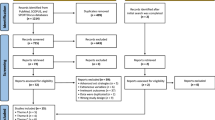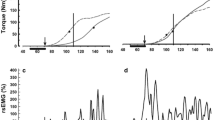Abstract
Purpose
To examine the effects of neuromuscular electrical stimulation (NMES) and blood flow restricted (BFR) exercise on wrist extensors cross-sectional area (CSA), torque and hand functions compared NMES only in individuals with incomplete tetraplegia. The acute effect of an acute bout of NMES with BFR on flow mediated dilation (FMD) was compared with BFR only.
Method
Nine men completed 6 weeks twice weekly of bilateral NMES training of the wrist extensor muscles. The right forearm received NMES + BFR (30 % above the resting systolic blood pressure), while the left forearm received NMES only. The CSA of the extensor carpi radialis longus (ECRL) and extensor digitorum communis (EDC) muscles was measured on ultrasound images. Torque was measured isometrically and hand function with grasp and release test. Another eight men with SCI received NMES+BFR to the right forearm, while the left forearm received BFR only. Immediately, the FMD of the brachial artery was measured.
Result
Following training, the ECRL CSA was 17 % greater in the NMES+BFR forearm (mean difference = 0.6 cm2, p = 0.003) compared with the NMES only. The NMES+BFR had a 15 % increase in ECRL CSA (mean increase = 0.58 cm2, p = 0.048). FMD increased (p = 0.05) in the exercise arm (12 ± 3 %) compared with the control arm (6.5 ± 6 %).
Conclusion
NMES training with BFR is a strategy that can increase skeletal muscle size. NMES with and without BFR can improve wrist strength and hand function. The acute effects of NMES+BFR may suggest that an increase in FMD may partially contribute to skeletal muscle hypertrophy.

Similar content being viewed by others
Abbreviations
- ANCOVA:
-
Analysis of covariance
- BFR:
-
Blood flow restricted
- CSA:
-
Cross-sectional area
- ECRL:
-
Extensor carpi radialis longus m
- EDC:
-
Extensor digitorum communis m
- FMD:
-
Flow mediated dilation
- HR:
-
Heart rate
- NMES:
-
Neuromuscular electrical stimulation
- NMES+BFR:
-
Neuromuscular electrical stimulation and blood flow restricted
- NO:
-
Nitric oxide
- ROM:
-
Range of motion
- SCI:
-
Spinal cord injury
References
Abe T, Yasuda T, Midorikawa T et al (2005) Skeletal muscle size and circulating IGF-1 are increased after 2 weeks of twice daily Kaatsu resistance training. Int J KAATSU Training Res 1:6–12
Abe T, Kearns CF, Sato Y (2006) Muscle size and strength are increased following walk training with restricted venous blood flow from the leg muscle, Kaatsu-walk training. J Appl Physiol (1985) 100(5):1460–1466
Abe T, Loenneke JP, Fahs CA, Rossow LM, Thiebaud RS, Bemben MG (2012) Exercise intensity and muscle hypertrophy in blood flow-restricted limbs and non-restricted muscles: a brief review. Clin Physiol Funct Imaging 32(4):247–252
Agewall S, Doughty RN, Bagg W, Whalley GA, Braatvedt G, Sharpe N (2001) Comparison of ultrasound assessment of flow-mediated dilatation in the radial and brachial artery with upper and forearm cuff positions. Clin Physiol 21(1):9–14
Alon G, McBride K (2003) Persons with C5 or C6 tetraplegia achieve selected functional gains using a neuroprosthesis. Arch Phys Med Rehabil 84(1):119–124
Alon G, Levitt AF, McCarthy PA (2007) Functional electrical stimulation enhancement of upper extremity functional recovery during stroke rehabilitation: a pilot study. Neurorehabil Neural Repair 21(3):207–215
Anderson KD (2004) Targeting recovery: priorities of the spinal cord-injured population. J Neurotrauma 21(10):1371–1383
Betik AC, Luckham VB, Hughson RL (2004) Flow-mediated dilation in human brachial artery after different circulatory occlusion conditions. Am J Physiol 286:H442–H448
Burgomaster KA, Moore DR, Schofield LM, Phillips SM, Sale DG, Gibala MJ (2003) Resistance training with vascular occlusion: metabolic adaptations in human muscle. Med Sci Sports Exerc 35:1203–1208
Castro MJ, Apple DF Jr, Hillegass EA, Dudley GA (1999) Influence of complete spinal cord injury on skeletal muscle cross-sectional area within the first 6 months of injury. Eur J Appl Physiol Occup Physiol 80(4):373–378
Credeur DP, Hollis BC, Welsch MA (2010) Effects of handgrip training with venous restriction on brachial artery vasodilation. Med Sci Sports Exerc 42(7):1296–1302
DeVivo MJ (1997) Causes and costs of spinal cord injury in the United States. Spinal Cord 35(12):809–813
Erskine RM, Jones DA, Maganaris CN et al (2009) In vivo specific tension of the human quadriceps femoris muscle. Eur J Appl Physiol 106:827–838
Gorgey AS, Dudley GA (2007) Skeletal muscle atrophy and increased intramuscular fat after incomplete spinal cord injury. Spinal Cord 45(4):304–309
Gorgey AS, Gater DR (2012) Insulin growth factors may explain relationship between spasticity and skeletal muscle size in men with spinal cord injury. J Rehabil Res Dev 49(3):373–380
Gorgey AS, Mahoney E, Kendall T, Dudley GA (2006) Effects of neuromuscular electrical stimulation parameters on specific tension. Eur J Appl Physiol 97(6):737–744
Gorgey AS, Mather KJ, Cupp HR, Gater DR (2012) Effects of resistance training on adiposity and metabolism after spinal cord injury. Med Sci Sports Exerc 44(1):165–174
Gorgey AS, Dolbow DR, Dolbow JD, Khalil RK, Castillo C, Gater DR (2014a) Effects of spinal cord injury on body composition and metabolic profile–part I. J Spinal Cord Med 37(6):693–702
Gorgey AS, Timmons MK, Michener LA, Ericksen JJ, Gater DR (2014b) Intra-rater reliability of ultrasound imaging of wrist extensor muscles in patients with tetraplegia. PM R 6(2):127–133
Harris RA, Nishiyama SK, Wray DW, Richardson RS (2010) Ultrasound assessment of flow-mediated dilation. Hypertension 55(5):1075–1085
Jacobson JA (2009) Musculoskeletal ultrasound: focused impact on MRI. AJR Am J Roentgenol 193:619–627
Kjaer M, Dela F, Sørensen FB, Secher NH, Bangsbo J, Mohr T, Galbo H (2001) Fatty acid kinetics and carbohydrate metabolism during electrical exercise in spinal cord-injured humans. Am J Physiol Regul Integr Comp Physiol 281(5):R1492–R1498
Mahoney ET, Bickel CS, Elder C et al (2005) Changes in skeletal muscle size and glucose tolerance with electrically stimulated resistance training in subjects with chronic spinal cord injury. Arch Phys Med Rehabil 86(7):1502–1504
Marino RJ, Ditunno JF Jr, Donovan WH, Maynard F Jr (1999) Neurologic recovery after traumatic spinal cord injury: data from the model spinal cord injury systems. Arch Phys Med Rehabil 80(11):1391–1396
Nash MS, Montalvo BM, Applegate B (1996) Lower extremity blood flow and responses to occlusion ischemia differ in exercise-trained and sedentary tetraplegic persons. Arch Phys Med Rehabil 77:1260–1265
National Spinal Cord Injury Statistical Center (2015) Available at: https://www.nscisc.uab.edu. Accessed 7th Dec 2015
Pearson SJ, Hussain SR (2015) A review on the mechanisms of blood-flow restriction resistancetraining-induced muscle hypertrophy. Sports Med 2:187–200
Popovic MR, Kapadia N, Zivanovic V et al (2011) Functional electrical stimulation therapy of voluntary grasping versus only conventional rehabilitation for patients with subacute incomplete tetraplegia: a randomized clinical trial. Neurorehabil Neural Repair 25:433–442
Powell J, Pandyan AD, Granat M, Cameron M, Stott DJ (1999) Electrical stimulation of wrist extensors in poststroke hemiplegia. Stroke 30(7):1384–1389
Rosewilliam S, Malhotra S, Roffe C, Jones P, Pandyan AD (2012) Can surface neuromuscular electrical stimulation of the wrist and hand combined with routine therapy facilitate recovery of arm function in patients with stroke? Arch Phys Med Rehabil 93(10):1715–1721
Rupp R, Gerner HJ (2007) Neuroprosthetics of the upper extremity–clinical application in spinal cord injury and challenges for the future. Acta Neurochir Suppl 97:419–426
Ryan TE, Brizendine JT, Backus D, McCully KK (2013) Electrically induced resistance training in individuals with motor complete spinal cord injury. Arch Phys Med Rehabil 94(11):2166–2173
Sabatier MJ, Stoner L, Mahoney ET et al (2006) Electrically stimulated resistance training in SCI individuals increases muscle fatigue resistance but not femoral artery size or blood flow. Spinal Cord 44(4):227–233
Segal NA, Williams GN, Davis MC, Wallace RB, Mikesky AE (2015) Efficacy of blood flow-restricted, low-load resistance training in women with risk factors for symptomatic knee osteoarthritis. PM R 7(4):376–384
Smith BT, Mulcahey MJ, Betz RR (1996) Quantitative comparison of grasp and release abilities with and without functional neuromuscular stimulation in adolescents with tetraplegia. Paraplegia 34(1):16–23
Smith LW, Smith JD, Criswell DS (2002) Involvement of nitric oxide synthase in skeletal muscle adaptation to chronic overload. J Appl Physiol (1985) 92(5):2005–2011
Spungen AM, Adkins RH, Stewart CA et al (2003) Factors influencing body composition in persons with spinal cord injury: a cross-sectional study. J Appl Physiol (1985) 95(6):2398–2407
Stoner L, Sabatier M, VanhHiel L et al (2006) Upper vs lower extremity arterial function after spinal cord injury. J Spinal Cord Med 29:138–146
Stoner L, Sabatier MJ, Mahoney ET et al (2007) Electrical stimulation-evoked resistance exercise therapy improves arterial health after chronic spinal cord injury. Spinal Cord 45:49–56
Takarada Y, Nakamura Y, Aruga S, Onda T, Miyazaki S, Ishii N (2000a) Effects of resistance exercise combined with moderate vascular occlusion on muscular function in humans. J Appl Physiol 88:2097–2106
Takarada Y, Nakamura Y, Aruga S, Onda T, Miyazaki S, Ishii N (2000b) Rapid increase in plasma growth hormone following low-intensity resistance exercise with vascular occlusion. J Appl Physiol 88:61–65
Takarada Y, Takazawa H, Ishii N (2000c) Applications of vascular occlusion diminish disuse atrophy of knee extensor muscles. Med Sci Sports Exerc 32(12):2035–2039
Wijman CA, Stroh KC, Van Doren CL, Thrope GB, Peckham PH, Keith MW (1990) Functional evaluation of quadriplegic patients using a hand neuroprosthesis. Arch Phys Med Rehabil 71(13):1053–1057
Author information
Authors and Affiliations
Corresponding author
Additional information
Communicated by Guido Ferretti.
Rights and permissions
About this article
Cite this article
Gorgey, A.S., Timmons, M.K., Dolbow, D.R. et al. Electrical stimulation and blood flow restriction increase wrist extensor cross-sectional area and flow meditated dilatation following spinal cord injury. Eur J Appl Physiol 116, 1231–1244 (2016). https://doi.org/10.1007/s00421-016-3385-z
Received:
Accepted:
Published:
Issue Date:
DOI: https://doi.org/10.1007/s00421-016-3385-z




